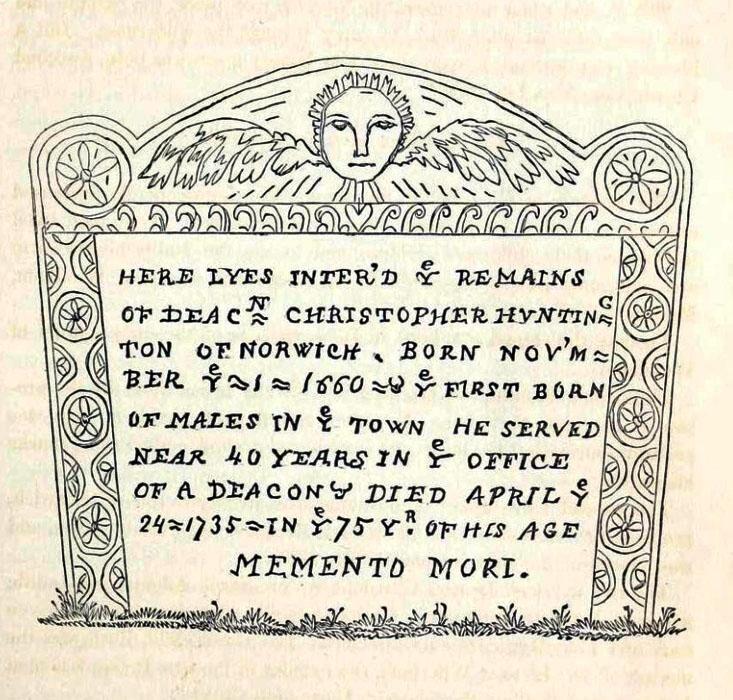1660-present: First Congregational Church ~ Norwichtown
James Fitch sailed to America in 1638 at the age of 16, along with his parents and Reverend Thomas Hooker. Fitch spent seven years of theological study in Hartford under the tutelage of Reverend Hooker, an esteemed Congregational minister and one of the founders of the Colony of Connecticut.
In 1646, Fitch was ordained to minister to his congregation in Saybrook Point. Thirteen years later, he led his congregation from Saybrook to Norwich and became the first minister of the First Congregational Church. Regarding the congregation move from Saybrook to Norwich, Info Source 1 states: “The venerable Mr. Fitch leading the way, and his pilgrim followers, old and young, singly or in groups, scattered along the pathway and gathering at the sacred path.”
The First Congregational Church of Norwich is deeply embedded in Norwich’s history. Over the past 365 years, the congregation has used five buildings for their meeting house. A courthouse, shops, residences, and more than one tavern accompanied the church on the Norwichtown Green.
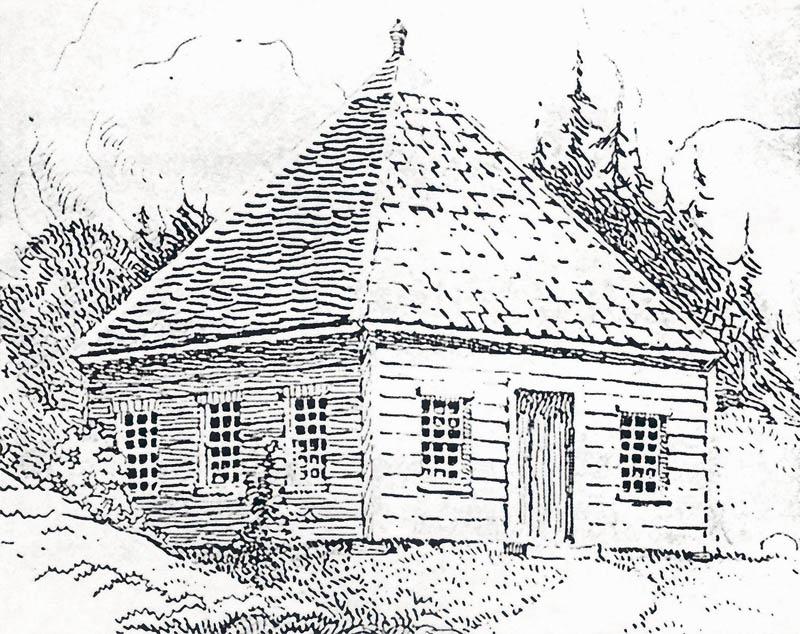
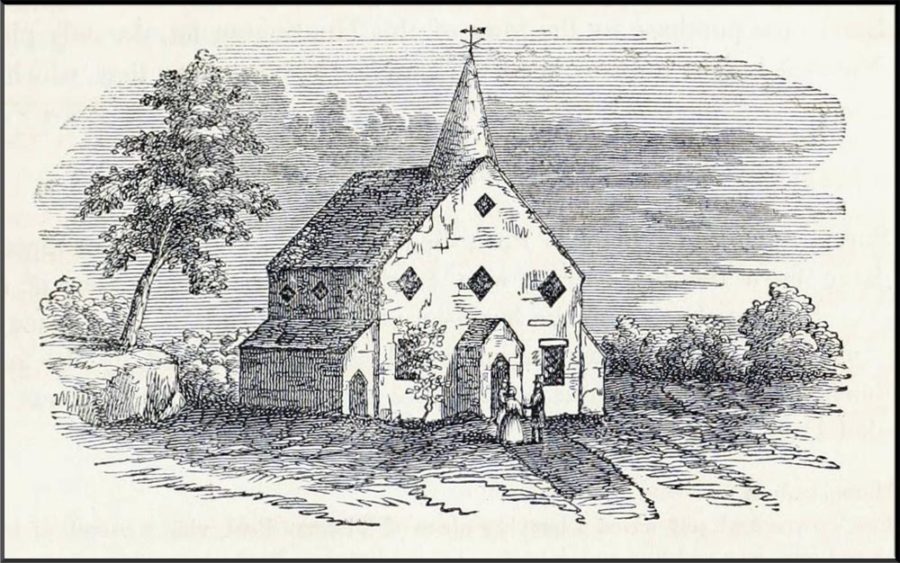

First Meeting House 1660-1673
The first structure, a small square-shaped building, was built on the southeast corner of the Green in 1660 in Norwichtown, the earliest part of Norwich to be settled. It was built by a local carpenter, John Elderkin. Info source 1 states: “We may conjecture that a sun-dial stood near the door, and perhaps a horse-block. It was undoubtedly furnished with a pulpit, though no tasseled cushion supported the open Bible. In all probability long benches were used instead of pews, — the men sitting on the right hand of the minister, and the women on the left. A choir of singers was then unknown; the deacon read off the lines, and the congregation followed in tuneful quavers.”
The church was built opposite the houses of Major John Mason and Reverend James Fitch, the men who led settlers from Saybrook to Norwich. At that time, the more important you were in a settlement, the closer you lived to the church. Living near the church was a convenience. Regarding church attendance in the early days, Norwich’s City Historian Dale Plummer said, “You were required by law to attend church every Sunday, on pain of corporal punishment or fines.” (Info Source 2)
Notable Church Members During This Period
Major John Mason: During his twelve years in Norwich, John Mason served nine years as Deputy Governor (1660 to 1669) and helped write the Connecticut Charter. He served as acting Governor of Connecticut from 1661 to 1663. Major Mason’s daughter, Priscilla, married Reverend James Fitch. Another of Major Mason’s daughters, Elizabeth, married Reverend James Fitch’s son, James Fitch Jr.
Lt. Thomas Leffingwell: In 1694, when Reverend Fitch could no longer fulfill his duties as the town clergy, Thomas Leffingwell (and four others) was appointed chairman of the committee to plead with Mr. Fitch’s son Jabez to take over for his father. Also, four years later, after the enlargement and repair of the Church, Thomas was appointed to coordinate the seating of the members according to their rank within the congregation.
Second Meeting House 1673-1713
John Elderkin and Samuel Lathrop built the second meeting house upon the rocky ledge just west of today’s meeting house. It was built on land initially allotted to Stephen Gifford, one of Norwich’s first proprietors. Gifford sold his lot, which included about six acres of land, his house, orchard, pasture, and fences to the Town of Norwich. The lot was granted to Reverend Woodward two years later, and the land became known as the “parsonage lot.” After Reverend Woodward left Norwich and the new pastor arrived, the land was granted to Reverend Dr. Benjamin Lord.
The meeting house was constructed during the troubled period of King Philip’s War. The rocky ledge served three purposes: a place of worship, a watchtower against the Indians, and a garrison post. According to Info Source 1: “To this church, until all fear of the Indians had passed away, the men of the congregation were accustomed to repair with muskets upon their shoulders, which were not, however, carried into the house, but stacked without and kept under watch and guard by some person conveniently stationed for that purpose. The regular soldiers, or militiamen, went in last and sat near the door to be ready in case of alarm.”
On occasion, the congregation still uses the spot for outdoor worship today.
Notable Church Members During This Period
Deacon Simon Huntington Jr. (1629-1706): He was one of Norwich’s founding fathers and among the first group of Deacons of the church. He served as a Deacon for 46 years. Upon his death, his son, Simon III (b1659-d1636) became a Deacon. The line of succession of Huntington Deacons in the First Congregational Chruch passed from father to son for seven generations, encompassing 120 years.
Deacon Christopher Huntington Jr. (1660-1750): On November 1, 1660, Christopher became the 1st born male child born in Norwich. Christopher Huntington Jr. served as a Deacon for the church from 1696 to 1735 (39 years) and executed the office of Town Clerk and Recorder for 20 years.
Christopher Huntington Jr. was the first person interred at the old Norwichtown burial ground. A sketch of his gravestone, first printed in 1866, is shown on the left.
Third Meeting House 1713-1770
On 12/06/1709, a vote was passed to build a new meeting house with dimensions not exceeding 55 feet by 45, to be modeled by a church committee and to be completed by 01/01/1712. The third meeting house was completed for service in December of 1713. It was built on the hill, near the site of the second meeting house. John Elderkin 2nd, the son of the 1st and 2nd meeting house builder, was the architect for the new building.
One of the fixtures of the third meeting house was an hourglass placed in a frame and fastened to the pulpit. In 1729, Captain Joseph Tracy was charged with operating this hourglass. His jobs were to turn it when it ran out of service time and ensure that time was kept between meetings. The bellman was charged with ringing a bell upon Tracy’s order.
Sarah Knight Communion Cup
*Place cursor over image to magnify
Sarah Kemble Knight: She was a teacher and businesswoman best remembered for a brief diary of her journey from Boston to New York City in 1704–1705. She operated a tavern across the street from the 1st Congregational Church and valued her membership in the church.
“On Aug. 12, 1717, Sarah Knight joined the church, and town records show that she was granted her liberty “to sitt in the pue where she use to sitt in ye meetinghouse.” Sarah apparently valued her membership at the church, because in 1722 she donated a silver goblet to be used as the communion cup. …”
“The Sarah Knight Communion Cup stayed in the possession of the church until the early 1900s when it was sold to George Palmer of New London for $1,000 to raise funds for the church. It is now at the Museum of Fine Arts in Boston.”
“Sarah, daughter of Thomas and Elizabeth Kemble, gift from her in 1722 to the Church of Christ, Norwich, Connecticut.”
Third Meeting House Floor Plan (1756-1761)
The image below shows the ground-level floor plan of the 3rd meeting house during the years 1756-1761. The arrangement and seating for the gallery (a.k.a. second floor) can be viewed in Image Source 1). The minister’s family sat next to the Pulpit, and below him sat the Deacons.
Before 1791, the pews were not sold yearly. Instead, they were family possessions, and two names on the same pew-box did not always indicate joint occupancy but possibly an inheritance or a sale from one owner to another.
The floor plan shows the layout and prices paid for the pew boxes. Upon inspection, it is clear that pews nearer the front and center were more valuable.
The first annual pew sales (a.k.a. rentals) occurred in 1791.
*Place cursor over image to magnify
Benedict Arnold Jr. the notorious traitor, was baptized in the third meeting house on 01/11/1741. During the time period of this floor plan, he would have been about 19 years old. Upon inspection of the floor plan, Benedict Arnold Sr. paid £18 for his family’s pew box (pew box #45). Eighteen British pounds in 1760 would be worth approximately $6,000 in today’s dollars.
In the 1760s, the Arnold family sat in one of the best pews in the meeting house, which indicated their high community status. However, as the Arnold family’s finances declined and his father’s alcoholism increased, the family underwent the public humiliation of being resigned to the gallery for poor people.
Benedict Arnold Junior’s father was arrested on several occasions for public drunkenness and was refused communion at the church. Benedict’s mother, Hannah Waterman Arnold, was cruelly reminded every Sunday of how her family’s fortunes had fallen.
Fourth Meeting House 1770-1801
A fourth meeting house began construction in 1753 at the site of the present-day church and was completed just under the Meeting House Rocks in 1770. It was said to have been a square building with a porch or platform. The interior was furnished with pews, a pulpit, and slips (a.k.a. special pews) for aged people and strangers. Low benches were placed in the aisles for children. The front of the pulpit displayed in large letters the sacred motto:
HOLINESS BECOMETH GOD’S HOUSE
A town clock was purchased and placed in the meeting house belfry. In 1772, a large pulpit Bible was purchased.
Unfortunately, on February 7, 1801, the meeting house and two nearby barns were consumed to ashes by an arsonist. Four years previous, in February 1797, several unsuccessful attempts had been made to destroy the house of worship. At that time, Mayor John McClaren Breed issued a proclamation offering a reward of $500 (approximately $12,500 in today’s $) for discovering the culprit. A vigilant watch was also kept in the church’s vicinity for some time, and no further attempt was made. However, fires were kindled, and several barns were consumed in different parts of the town. The culprit was never discovered.
Thankfully, the Bible was saved from the flames.
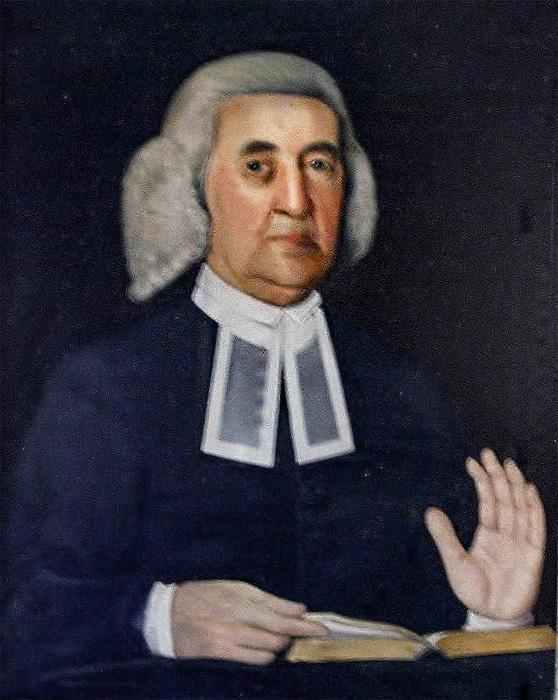
Prominent Member During This Period
Reverend Dr. Benjamin Lord (1694-1784): In June of 1717, Benjamin Lord was invited unanimously to become the minister of the First Congregational Church. He was ordained on November 20, 1717, and performed his pastoral labors almost without interruption until his death in 1784. He served the church for 67 years. Dr. Lord was considered an earnest evangelical preacher, and his ministry was eminently helpful and successful.
Many more prominent members of the church during this period are discussed in Info Source 1.
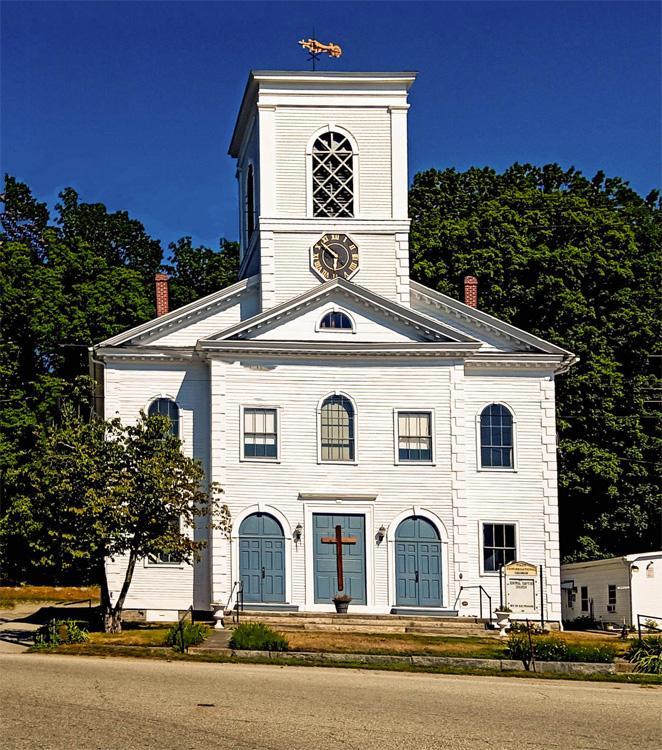
Fifth Meeting House 1801- present
After the 1770 church burned, the current Federal-style structure was built on the same site. Revolutionary War General Ebenezer Huntington laid the cornerstone of the present Church on June 18, 1801.
President Millard Fillmore’s cousin, Lavius Fillmore, a Norwich native, was the church’s architect. The wealthiest church members paid for a pew closest to the altar to be closer to God.
Stoves were introduced in 1810, and the Sabbath School commenced about 1820. The original structure was extensively remodeled in 1845. The present chapel was erected in 1852, the site being a gift from Mrs. Harriet Peck Williams to the society.
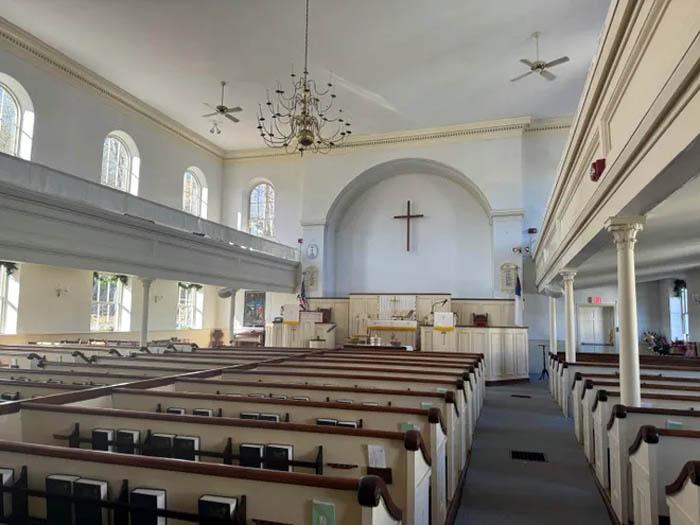
Much more information about the history of the First Congregational Church is provided in Info Source 2
Acknowledgements
Many thanks to Dave Oat for his contributions to this article
“History of Norwich, Connecticut: From Its Possession From the Indians; to the Year 1866,” ppg 21,119,182,and 340, by Frances Manwaring Caulkins
“Old Houses of the antient town of Norwich, 1660-1800”, (1895), ppg. 352, 603, by Mary Elizabeth Perkins
“History of the First Congregational Church,” by Dave Oat, Published in “The Norwich Historical Society’s The 9-Mile Square,” (2005), ppg 197-198
The complete list of sources may be found by clicking the “Bibliography” button, and, then typing “First Congregational” in the SEARCH box.
